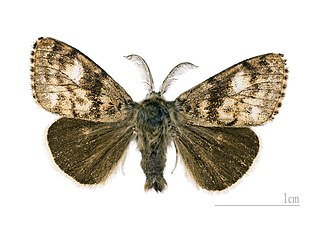
Lepidoptera is an order of insects that includes butterflies and moths. About 180,000 species of the Lepidoptera are described, in 126 families and 46 superfamilies, 10 per cent of the total described species of living organisms. It is one of the most widespread and widely recognizable insect orders in the world. The Lepidoptera show many variations of the basic body structure that have evolved to gain advantages in lifestyle and distribution. Recent estimates suggest the order may have more species than earlier thought, and is among the four most speciose orders, along with the Hymenoptera, Diptera, and Coleoptera.

The Noctuidae, commonly known as owlet moths, cutworms or armyworms, are the most controversial family in the superfamily Noctuoidea because many of the clades are constantly changing, along with the other families of the Noctuoidea. It was considered the largest family in Lepidoptera for a long time, but after regrouping Lymantriinae, Catocalinae and Calpinae within the family Erebidae, the latter holds this title now. Currently, Noctuidae is the second largest family in Noctuoidea, with about 1,089 genera and 11,772 species. However, this classification is still contingent, as more changes continue to appear between Noctuidae and Erebidae.

The Arctiinae are a large and diverse subfamily of moths, with around 11,000 species found all over the world, including 6,000 neotropical species. This group includes the groups commonly known as tiger moths, which usually have bright colours, footmen, which are usually much drabber, lichen moths, and wasp moths. Many species have "hairy" caterpillars that are popularly known as woolly bears or woolly worms. The scientific name of this subfamily refers to this hairiness. Some species within the Arctiinae have the word “tussock” in their common name due to people misidentifying them as members of the Lymantriinae based on the characteristics of the larvae.

The Ditrysia are a natural group or clade of insects in the lepidopteran order containing both butterflies and moths. They are so named because the female has two distinct sexual openings: one for mating, and the other for laying eggs.
Sir George Francis Hampson, 10th Baronet was a British entomologist.

Arthur Gardiner Butler was an English entomologist, arachnologist and ornithologist. He worked at the British Museum working on the taxonomy of birds, insects, and spiders.

Coleophora is a very large genus of moths of the family Coleophoridae. It contains some 1,350 described species. The genus is represented on all continents, but the majority are found in the Nearctic and Palaearctic regions. Many authors have tried splitting the genus into numerous smaller ones, but most of these have not become widely accepted.

The Arctiini are a tribe of tiger moths in the family Erebidae.

Nepticulidae is a family of very small moths with a worldwide distribution. They are characterised by eyecaps over the eyes. These pigmy moths or midget moths, as they are commonly known, include the smallest of all living moths, with a wingspan that can be as little as 3 mm in the case of the European pigmy sorrel moth, but more usually 3.5–10 mm. The wings of adult moths are narrow and lanceolate, sometimes with metallic markings, and with the venation very simplified compared to most other moths.

Eupterotidae is a family of insects in the order Lepidoptera with more than 300 described species.

Amphiesmenoptera is an insect superorder, established by S. G. Kiriakoff, but often credited to Willi Hennig in his revision of insect taxonomy for two sister orders: Lepidoptera and Trichoptera (caddisflies). In 2017, a third fossil order was added to the group, the Tarachoptera.

Glossata is the suborder of the insect order Lepidoptera that contains most lepidopteran species and includes all the superfamilies of moths and butterflies that have a coilable proboscis..
Myoglossata is a clade within suborder Glossata within order Lepidoptera, the butterflies and moths. It contains the family Neopseustidae and the clade Neolepidoptera. Myoglossata is considered a clade, that is, a group of organisms made up of a single common ancestor and all of its descendants. They are distinguished by "intrinsic mouthparts". These added intrinsic galeal muscles are unique to the Myoglossata and developed after the galeae changed to form sucking parts.

The Erebinae are a subfamily of moths in the family Erebidae. Erebine moths are found on all continents except Antarctica, but reach their greatest diversity in the tropics. While the exact number of species belonging to the Erebinae is not known, the subfamily is estimated to include around 10,000 species. Some well-known Erebinae include Underwing moths (Catocala), and Witch moths (Thermesiini). Many of the species in the subfamily have medium to large wingspans, up to nearly 30 cm in the White Witch moth, which has the widest wingspan of all Lepidoptera. Erebine caterpillars feed on a broad range of plants; many species feed on grasses and legumes, and a few are pests of castor bean, sugarcane, rice, as well as pistachios and blackberries.
The Global Lepidoptera Names Index (LepIndex) is a searchable database maintained by the Department of Entomology at the Natural History Museum, London.
Alexey Diakonoff full name Alexey Nikolaievich Diakonoff was a Russian entomologist who specialised in Microlepidoptera.
Euerythra phasma, the red-tailed specter, is a moth of the family Erebidae. It was described by Leon F. Harvey in 1876. It is found in the south-central United States, including Alabama, Arkansas, Florida, Georgia, Kentucky, Mississippi, Missouri, Oklahoma, Tennessee and Texas.
Euerythra trimaculata, the three-spotted specter, is a moth of the family Erebidae. It was described by Smith in 1888. It is found in central and southern Texas and the Florida Panhandle.

Eulepidoptera is a division of lepidopterans in the infraorder Heteroneura.














